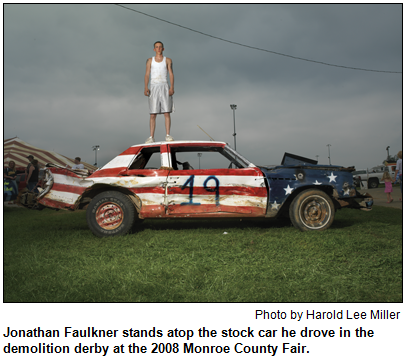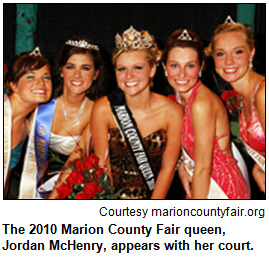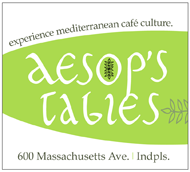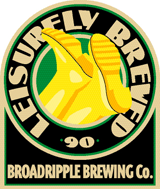You can listen to Hoosier History Live! live on the air each Saturday, or listen online at the WICR website during the broadcast on any computer with speakers, anywhere, or on a smartphone. We invite you to visit our website!
July 23 show
County fairs and Hoosier culture
 It's a summer ritual thousands of Hoosiers crow about from Elkhart County to Delaware, Dubois and Jackson counties: participating in - or flocking to attend - the county fair.
It's a summer ritual thousands of Hoosiers crow about from Elkhart County to Delaware, Dubois and Jackson counties: participating in - or flocking to attend - the county fair.
How have these annual celebrations affected our culture across Indiana? What does "fair culture" reveal about those who participate? And do Hoosiers (as well as other Midwesterners) approach our county fairs with different expectations and enthusiasm than our counterparts in other regions of America?
Join us as we gnaw on (or savor) these questions and a cauldron of other aspects related to the fairs in Indiana's 92 counties. Nelson will be joined in studio by the collaborators on an upcoming visual history book titled Fair Culture: Images from Indiana Fairs (Indiana Historical Society Press).
Among our guests will be Harold Lee Miller, an Indianapolis photographer who began taking pictures of 4-H participants at the poultry and rabbit barns of the Indiana State Fair. Then Harold "branched out" to photograph people and activities at county fairs across the state. Fair Culture features more than 100 of his images; they depict everything from sheep and cattle to antics on the midways.
 Nelson and Harold will be joined by Gerald Waite, a lecturer emeritus at Ball State University who was an anthropology instructor. Gerry's essay accompanies Harold's photos in Fair Culture and explores the history of fairs from the Middle Ages to contemporary times; it also delves into the growth of Indiana county fairs.
Nelson and Harold will be joined by Gerald Waite, a lecturer emeritus at Ball State University who was an anthropology instructor. Gerry's essay accompanies Harold's photos in Fair Culture and explores the history of fairs from the Middle Ages to contemporary times; it also delves into the growth of Indiana county fairs.
So what's the current popularity of our county fairs? Reports seem to be as different as chili recipes.
According to Fair Culture, the Elkhart County Fair in northern Indiana remains one of the largest in the entire country. It's second in size only to a fair in Orange County, Calif., Gerry notes. At the 2008 fair in Elkhart County, he reports, there were 1,000 "non-breathing" entries submitted for judging; they ranged from art projects to photos. (Harold's photos of the Elkhart County Fair include an image of a jeans-clad exhibitor cooling down his two hogs by squirting them with a mister as they are routed through a maze of gates.)
But hold your horses. An Associated Press report last week indicated some aspects of Hoosier county fairs are struggling.
"County fairs across Indiana are seeing interest wane in a staple of the events," the AP noted. Several of the state's 92 counties, for example, reported sharp declines in contestants in their queen pageants, with the Monroe County Fair indicating the least interest in 30 years.
 "Mixed" certainly describes the attractions at county fairs. For generations, the attractions have ranged from apple pie contests, farm equipment displays and swine barns to demolition derbies and midway enticements some consider a bit lurid.
"Mixed" certainly describes the attractions at county fairs. For generations, the attractions have ranged from apple pie contests, farm equipment displays and swine barns to demolition derbies and midway enticements some consider a bit lurid.
"Entertainment said to be frivolous, seedy, vulgar, or sometimes characterized as 'downright immoral' has been a part of the fair scene since at least the middle of the 19th Century," Gerry writes in Fair Culture.
He adds that such entertainment often has been "seen as a necessity by promoters of the fairs. ... Even the word 'concessions' was said to have originated as a concession to the lower classes."
In describing his photographic approach to county fairs, Harold indicates he sought to avoid a nostalgic or romantic approach, Instead, he describes his array of color images as "documentational."
Nelson plans to ask him how he was able to convince an array of multi-colored roosters and chickens to stand still for some striking images. The cover of Fair Culture features Harold's photo of a teenage boy exhibiting a white rooster at the Indiana State Fair.
Other photos depict harness racer Bob Morrow at the Jay County Fair, a plate of elephant ears (natch) at the state fair, the winner of the "Miss Backyard Sugar Shack" contest at the Elkhart County Fair, and Monroe County resident Jonathan Faulkner standing on the roof of his red, white and blue muscle car.
A bushel of fun facts:
- Indiana's earliest fair, according to Fair Culture, was the Knox County Fair in 1809.
- The first Indiana State Fair marching band contest was held in 1947, also according to Fair Culture.
- During the early 1950s, attendance dropped at some county fairs because of the polio epidemic.
 This year's Marion County Fair kicked off Thursday, July 21.
This year's Marion County Fair kicked off Thursday, July 21.
Roadtrip: Marion County Fair
Chris Gahl of the ICVA suggests the Marion County Fair this week as a Roadtrip pick. The fair is located in the southeastern corner of Marion County, near the intersection of I-465 and I-74 and runs through Saturday, July 30.
Events on Saturday, July 23, include the Battle of the Bands from 5 to 9 p.m., motorcycle races at 7 p.m., and the Queen and Princess pageant at 8 p.m. A printable Marion County Fair map is available to guide you toward the fun!
History Mystery
A frequent entry in pie contests at county fairs across Indiana, it was named the state's official pie in 2009. The world's largest maker of it is Wick's Pies in Randolph County. According to food historians, this type of pie has a heritage associated with Hoosier farms because its ingredients primarily include staples almost always on hand in rural kitchens.
 Question: What kind of pie, long associated with farm life, is now the official state pie of Indiana?
Question: What kind of pie, long associated with farm life, is now the official state pie of Indiana?
To win the prize, you must call in with the correct answer during the live show. Please do not call if you have won a prize from any WICR show during the last two months. The call-in number is (317) 788-3314, and please do not call until you hear Nelson pose the question on the air. The prize is four tickets to Conner Prairie Interactive History Park, courtesy of the ICVA.
Your Hoosier History Live! team,
Nelson Price, host and creative director
Molly Head, producer, (317) 927-9101
Chris Gahl, Roadtripper
Richard Sullivan, webmaster and tech director
Pam Fraizer, graphic designer
Garry Chilluffo, creative consultant
Michele Goodrich, Jed Duvall, grant consultants
www.hoosierhistorylive.org





Please tell our sponsors that you appreciate their support: Aesop's Tables, Broad Ripple Brewpub, Indiana Historical Society, Lucas Oil and Story Inn.
 Acknowledgments to Print Resources, Indianapolis Marion County Public Library, Monomedia, Indiana Humanities, Indianapolis Convention & Visitors Association, WICR-FM, Fraizer Designs, Heritage Photo and Research Services, Chelsea Niccum and many other individuals and organizations. We are an independently produced program and are self-supporting through organizational sponsorships, grants and through individual tax-deductible contributions through the Indiana Humanities Council. Visit our website to learn how you can support us financially.
Acknowledgments to Print Resources, Indianapolis Marion County Public Library, Monomedia, Indiana Humanities, Indianapolis Convention & Visitors Association, WICR-FM, Fraizer Designs, Heritage Photo and Research Services, Chelsea Niccum and many other individuals and organizations. We are an independently produced program and are self-supporting through organizational sponsorships, grants and through individual tax-deductible contributions through the Indiana Humanities Council. Visit our website to learn how you can support us financially.
Your support keeps us going
Recent contributions keep e-newsletter arriving professionally
A recent budget crunch almost forced us to go back to our pre-email-marketing-software days, when our producer was composing and sending out the weekly enewsletter with her 2002 version of Outlook Express. Not so pretty!
Our project is self-supporting and relies on sponsorship dollars and contributions.  Thanks to Bob and Melissa Dora, Sally Cook, Dana Waddell and Clay Collins, and James and Elizabeth Worley of Columbus, Ind., and a couple of anonymous folks for their recent contributions.
Thanks to Bob and Melissa Dora, Sally Cook, Dana Waddell and Clay Collins, and James and Elizabeth Worley of Columbus, Ind., and a couple of anonymous folks for their recent contributions.
Hoosier History Live! needs to keep moving forward. It is our goal to eventually have funding in place so that all of our past show e-newsletters can be professionally archived on our website, along with the full audio of each show.
While many newspapers, magazines and broadcasting projects continue to shrink or disappear, Hoosier History Live! creates rich new content each week, both on the radio airwaves and on our weekly e-newsletter and website.
Would you like to help preserve that content for generations to come? Visit "Support the show" on our website. We're serious!
© 2011 Hoosier History Live! All rights reserved.